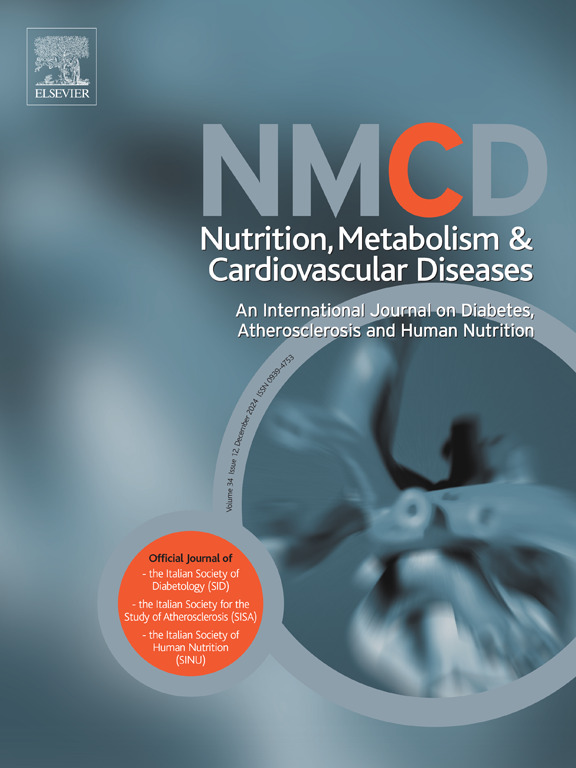超加工食品、遗传风险与心血管代谢疾病和心血管代谢多病风险:一项前瞻性研究。
IF 3.3
3区 医学
Q2 CARDIAC & CARDIOVASCULAR SYSTEMS
Nutrition Metabolism and Cardiovascular Diseases
Pub Date : 2024-09-17
DOI:10.1016/j.numecd.2024.09.011
引用次数: 0
摘要
背景和目的:本研究旨在评估超加工食品(UPF)对2型糖尿病(T2D)、心血管疾病(CVD)、高血压和心脏代谢多病症(CMM)的影响,并探讨遗传易感性在这些关联中的作用:研究纳入了英国生物库中的 90 631 名参与者(收集时间为 2006 年至 2010 年)。评估的结果包括T2D、心血管疾病、高血压和CMM。采用 Cox 比例危险模型评估这些结果之间的关联以及遗传风险对结果的潜在影响,遗传风险是通过多基因风险评分(PRS)估算出来的。UPF消耗量高的参与者罹患T2D、心血管疾病和CMM的风险较高,调整后的危险比(HR)分别为1.36(95%置信区间[CI]:1.15,1.61)、1.13(95%CI:1.03,1.23)和1.14(95%CI:1.05,1.24)。UPF消耗量高且T2D、心血管疾病和高血压PRS高的人患T2D(HR:4.01;95%CI:2.83,5.69)、心血管疾病(HR:2.18;95%CI:1.86,2.56)和高血压(HR:1.79;95%CI:1.61,1.99)的风险分别最高。在患有一种心脏代谢疾病(CMD)的参与者中,UPF消耗量高、PRST2D或PRSCVD高的人患CMM的风险最高。PRST2D和UPF摄入量对T2D风险有明显的叠加作用:我们的研究强调了识别UPF消耗量高的个体进行有针对性的膳食干预以降低CMD和CMM风险的重要性,尤其是在CMD遗传风险高的人群中。本文章由计算机程序翻译,如有差异,请以英文原文为准。
Ultra-processed food, genetic risk, and the risk of cardiometabolic diseases and cardiometabolic multimorbidity: A prospective study
Background and aims
This study aims to evaluate the impact of ultra-processed food (UPF) on type 2 diabetes (T2D), cardiovascular disease (CVD), hypertension, and cardiometabolic multimorbidity (CMM), and to explore the role of genetic susceptibility in these associations.
Methods and results
90 631 participants from the UK Biobank were included (collected between 2006 and 2010). The outcomes assessed included T2D, CVD, hypertension and CMM. The Cox proportional hazards model was used to evaluate their associations and the potential modification by genetic risk, which was estimated using the polygenic risk score (PRS). Participants with high UPF consumption had a higher risk of T2D, CVD, and CMM, with the adjusted hazard ratio (HR) of 1.36 (95 % confidence interval [CI]: 1.15, 1.61), 1.13 (95%CI: 1.03, 1.23), and 1.14 (95%CI: 1.05, 1.24), respectively. Those with high UPF consumption and high PRS for T2D, CVD, and hypertension had the highest risk of T2D (HR: 4.01; 95%CI: 2.83, 5.69), CVD (HR: 2.18; 95%CI: 1.86, 2.56), and hypertension (HR: 1.79; 95%CI: 1.61, 1.99), respectively. In participants with one cardiometabolic disease (CMD), those with high UPF consumption and high PRST2D or PRSCVD had the highest risk of developing CMM. A significant additive interaction was observed between PRST2D and UPF consumption on the risk of T2D.
Conclusion
Our study underscored the importance of identifying individuals with high UPF consumption for targeted dietary interventions to mitigate the risk of CMDs and CMM, particularly among those with a high genetic risk of CMDs.
求助全文
通过发布文献求助,成功后即可免费获取论文全文。
去求助
来源期刊
CiteScore
6.80
自引率
2.60%
发文量
332
审稿时长
57 days
期刊介绍:
Nutrition, Metabolism & Cardiovascular Diseases is a forum designed to focus on the powerful interplay between nutritional and metabolic alterations, and cardiovascular disorders. It aims to be a highly qualified tool to help refine strategies against the nutrition-related epidemics of metabolic and cardiovascular diseases. By presenting original clinical and experimental findings, it introduces readers and authors into a rapidly developing area of clinical and preventive medicine, including also vascular biology. Of particular concern are the origins, the mechanisms and the means to prevent and control diabetes, atherosclerosis, hypertension, and other nutrition-related diseases.

 求助内容:
求助内容: 应助结果提醒方式:
应助结果提醒方式:


